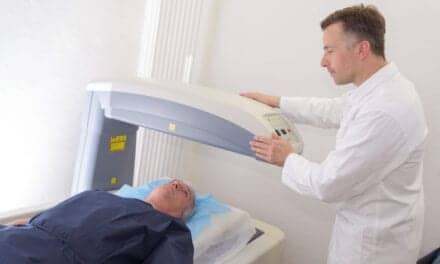by Richard B. Elsberry
Online education is providing an efficient resource for radiologist and technologist CME credits.

|
Online classrooms are fast becoming a major trend in the field of advanced education. In the past 2 years, thousands of students in a variety of fields have made the Internet their college campus.
Cyber universities enable their students to learn online at home or at the office rather than on-campus. Almost overnight the University of Phoenix online has become the largest private university in America, offering interactive classes with online professors at a cost of $400 per course. You can even get an MBA online. Duke University offers a 20-month program to students worldwide. It costs $70,000.
The rush to Internet education is also changing how hospital radiology departments train their residents and provide their staffs with continuing medical education (CME) opportunities.
Participation in off-site meetings and seminars is being severely curtailed by many hospitals because of the time and the cost involved. Also fading fast is the ACR Learning File, which in the 1980s was a series of film jackets that checked competency and gave some training to residents. They were transferred to laser disks in the early 1990s and then to CD-ROMs in the mid 1990s. The reason: at that time, downloading from the Internet was an extremely slow process and DSL (digital subscriber line) modems were not available for home use. It should also be noted that few hospital computers 5 years ago had CD-ROM drives.
All that has changed in the last 2 years. Now, a wide variety of online Internet educational programming is available to radiologists, radiology residents, technologists, and administrators through major medical centers and diagnostic imaging equipment vendors.
Physician-Directed Support
Massachusetts General is now working on a project currently running in its laboratory that will enable radiologists who are uncertain of the pathology they see on their monitor to access similar cases. “To do so, the radiologist has to be able to describe the image he sees,” says Keith Dreyer, DO, PhD, Massachusetts General’s Vice Chairman of Radiology Computing and Information Sciences, and an assistant professor of radiology at Harvard Medical School. “To solve that problem, we have created a system that guides the user at his workstation to select the anatomical region, the modality, and the image slice or plane where they see the lesion. Then we provide a list of up to 20 to 25 thumbnails of available reference images with pathologies in the same location, along with reference information, standard protocols for follow-up procedures, the latest information about the disease, and other things they should look for.”
CME credit also will be available to users for the time they spend investigating that additional information.
“Because of the way we have set up the system, the searches will be essentially instantaneous,” says Dreyer. “All the radiologists have to do is to click where they see the pathology on that reference image, and that will initiate the search. It will take less than a minute to get the information needed for a diagnosis-far less time in most cases than it would take to consult a textbook with outdated images or to call in a colleague. But if you want to read more information about it before you discuss it with a neurosurgeon, you might want to take an extra 5 minutes.”
Massachusetts General plans to show the online search software at this fall’s RSNA, and to make it commercially available in 2002 through PACS vendors. Currently, it is concentrating on neuroradiology, but has signed up teams in other subspecialties to author the content. One fellow and three engineers are responsible for the development of the product.
Dreyer believes the reason Internet information in the past has not been as useful as it might have been is because people have tried to convert full textbooks to the Web, and that is not a comfortable way to learn. Still, a major advantage over CD-ROM is that information can be brought up to date instantaneously.
Courses for Residents, Technologists
Online learning also is being targeted to radiology residents. Perry Sprawls, PhD, a medical physicist and professor of radiology at Emory University in Atlanta, has created an online “Physical Principles of Medical Imaging” to help residents prepare for their board examinations. It is available free of charge on the Emory Web site (www.emory.edu/RADIOLOGY/). Although available only since July, within the first month it had 2,000 hits.
The online guide enables users to log on to look at any of 50 modules that basically provide an outline for self-study. Each module, which corresponds to a chapter in a textbook or a classroom session, can be downloaded for later offline study, says Sprawls.
Sprawls also has developed a 15-module “Principles of MRI” course, which is being used by his residents and, since early this year, has been nationally distributed by a vendor. It has been approved by the American Society of Radiologic Technologists for educating technologists, and is scheduled to be made available to residency programs in mid-September 2001. Each module requires about 1 hour of study time, and concludes with an online test. To get CME credit, technologists must have a 70% score. However, if they do not pass, they can retake the course.
This type of online program is becoming increasingly popular with radiology administrators. At the 620-bed Lenox Hill Medical Center in New York City, the largest independent hospital in Manhattan, online learning is being widely used to assure that the 70 to 80 staff technologists get the 12 Category A and 12 Category B CME credits they need every biennium to maintain their credentials.
Lenox’s administrative director of radiology, Gerry Durney, sees online learning as a cost-effective way to provide CME, as well as a good method for maintaining employee satisfaction. “What I like about it is that the employees can do it on their own time, and they can do it at home, which is a much nicer learning environment. Also, they can do it at their own pace, without workplace distractions.”
Solving Logistical Problems
Online learning also solves a host of administrative and logistical problems, says Durney. To view a live broadcast, you must have a room available, and not every radiology department has the necessary space. And how do you get your staff together to see it? And what about the people who work evenings and nights? “Even though we are located in Manhattan and training is available here, I am not going to let half of my 10 ultrasound technicians attend a day-long course.”
Durney is using online programs offered by several imaging equipment manufacturers, and is funding the training and arranging for CME credits as part of service contract and capital equipment negotiations. “I don’t think I am paying more for equipment, on the front end, by including online training in my contracts,” he believes. “Most OEMs are willing to provide it as an added value to close a deal.
“Right now I have enough credits in the bank to give each of my imaging professionals 12 Category A credits in each of the next 4 years.” Online CME credits also can be purchased for about $15 per credit per person, he notes. Durney has an administrator who monitors the CME program. “If I have 900 credits, I don’t want one of my technicians using 100 of them.
“Even if I had a budget where I could send people away for training, I’d rather take the funds and get as many people trained online as I could,” Durney says. “I don’t think you are getting the best performance for your dollar when you send people en masse to a course. “
In addition to online learning, Lenox Hill also has an in-house program where it offers group training once a month, but Durney notes that the program does not always reach everybody. He plans to complement both efforts with an interactive broadcast sponsored by an OEM who is willing to provide and install a satellite receiver. Although each program is aired twice, Durney notes that Category A credit is available only to those who view the show live; viewing the tape is good only for Category B credit.
As far as Gerry Durney is concerned, online learning is not just an elegant solution to providing CME, it is a godsend.
Richard B. Elsberry is a contributing writer for Decisions in Axis Imaging News.






